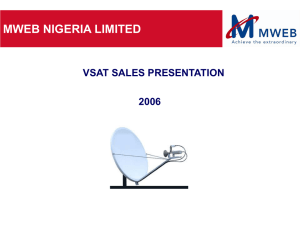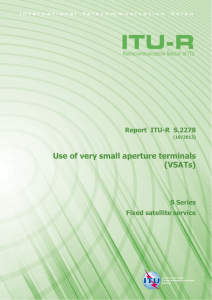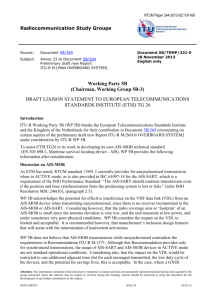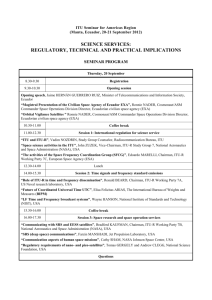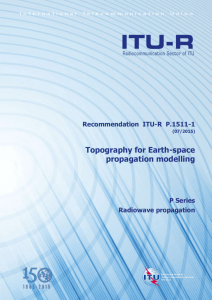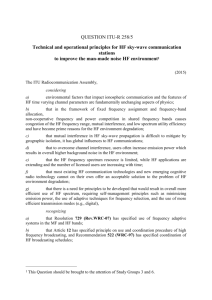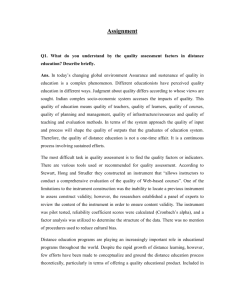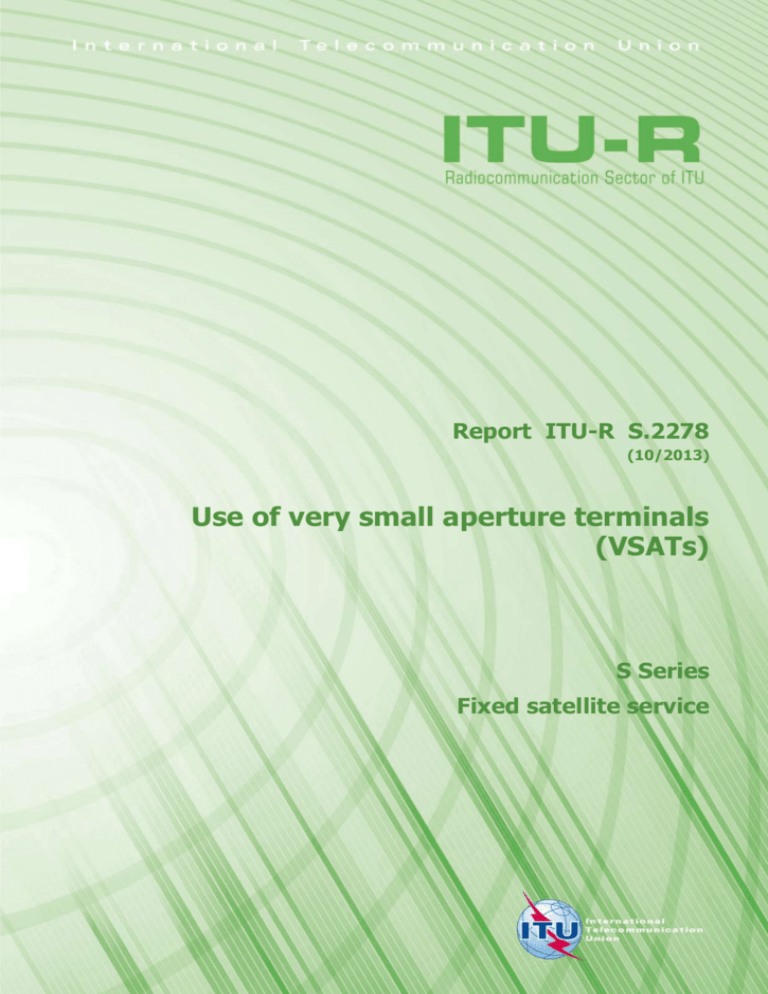
Report ITU-R S.2278
(10/2013)
Use of very small aperture terminals
(VSATs)
S Series
Fixed satellite service
ii
Rep. ITU-R S.2278
Foreword
The role of the Radiocommunication Sector is to ensure the rational, equitable, efficient and economical use of the
radio-frequency spectrum by all radiocommunication services, including satellite services, and carry out studies without
limit of frequency range on the basis of which Recommendations are adopted.
The regulatory and policy functions of the Radiocommunication Sector are performed by World and Regional
Radiocommunication Conferences and Radiocommunication Assemblies supported by Study Groups.
Policy on Intellectual Property Right (IPR)
ITU-R policy on IPR is described in the Common Patent Policy for ITU-T/ITU-R/ISO/IEC referenced in Annex 1 of
Resolution ITU-R 1. Forms to be used for the submission of patent statements and licensing declarations by patent
holders are available from http://www.itu.int/ITU-R/go/patents/en where the Guidelines for Implementation of the
Common Patent Policy for ITU-T/ITU-R/ISO/IEC and the ITU-R patent information database can also be found.
Series of ITU-R Reports
(Also available online at http://www.itu.int/publ/R-REP/en)
Series
BO
BR
BS
BT
F
M
P
RA
RS
S
SA
SF
SM
Title
Satellite delivery
Recording for production, archival and play-out; film for television
Broadcasting service (sound)
Broadcasting service (television)
Fixed service
Mobile, radiodetermination, amateur and related satellite services
Radiowave propagation
Radio astronomy
Remote sensing systems
Fixed-satellite service
Space applications and meteorology
Frequency sharing and coordination between fixed-satellite and fixed service systems
Spectrum management
Note: This ITU-R Report was approved in English by the Study Group under the procedure detailed in
Resolution ITU-R 1.
Electronic Publication
Geneva, 2014
ITU 2014
All rights reserved. No part of this publication may be reproduced, by any means whatsoever, without written permission of ITU.
Rep. ITU-R S.2278
1
REPORT ITU-R S.2278
Use of very small aperture terminals (VSATs)
(2013)
TABLE OF CONTENTS
Page
1
Introduction ....................................................................................................................
2
2
Characteristics of VSATs ...............................................................................................
2
2.1
Overview.............................................................................................................
2
2.2
Operational characteristics of VSATs ................................................................
2
2.3
Technical characteristics of VSATs ...................................................................
2
2.4
Antenna diameters ..............................................................................................
3
2.5
ITU-R Recommendations concerning technical and operational
characteristics for VSATs ...................................................................................
3
Topologies of networks with VSATs .............................................................................
7
3.1
Star type topology ...............................................................................................
7
3.2
Mesh type topology ............................................................................................
8
3.3
Hybrid topology ..................................................................................................
9
3.4
Point-to-point topology .......................................................................................
9
Features of operation of VSATs .....................................................................................
10
4.1
Initialization of the operation of a VSAT ...........................................................
10
4.2
Control and monitoring functions during the operation of a VSAT ...................
11
4.3
Other control and monitoring functions .............................................................
12
3
4
4.3.1
5
Management of the profiles of VSATs (location, satellite beam
contour and beam handover) ................................................................
12
4.3.2
Dynamic power control function during the operation of a VSAT .....
12
4.3.3
Adaptive coding and modulation function ...........................................
13
Conclusion ......................................................................................................................
14
2
1
Rep. ITU-R S.2278
Introduction
This Report provides a normative base describing technical and operational characteristics for very
small aperture terminals (VSAT) networks. Among the topics included are features of VSAT
operation, VSAT networks topologies, and control and monitoring functions.
It is emphasized that VSATs, while in motion (e.g. on board vessel, on land vehicle and on board
aircraft), are not encompassed by this Report.
2
Characteristics of VSATs
2.1
Overview
VSATs could be described as earth stations that share satellite resources among a large number of
similar terminals. Individual VSAT terminals typically have small aperture sizes, transmit at
relatively low equivalent isotropically radiated power (e.i.r.p.) levels, and use relatively small
equipment that allows flexible installation of a satellite network earth station directly at a wide
variety of user locations and platforms.
Technical and operational characteristics of VSATs are provided below.
2.2
Operational characteristics of VSATs
Some of the advantages of VSAT operational characteristics are:
–
local supervision of the terminal is not required;
–
allows for efficient use of shared satellite resources;
–
performance of the station is remotely monitored by a VSAT network control centre;
–
deployment in a geographical area without restrictions on installation density;
–
so as to ensure the VSAT is operating with the correct satellite and frequency, the VSAT
transmitter can only be enabled after having received authorization to do so via a signal
from the VSAT network control centre.
As a consequence of these characteristics, many administrations around the world allow blanket
licensing or simplified licensing procedures to allow quick deployment and easy operation of
VSAT networks.
2.3
Technical characteristics of VSATs
Technical characteristics of VSATs are:
–
while most VSAT networks make use of a star topology where a large hub is at the centre
of the star which communicates with remotes, other topologies are possible (see § 3);
–
dynamic assignment of satellite capacity to accommodate variable demand by a VSAT;
–
capability that allows compatibility with closely spaced satellites;
–
capability of VSAT to dynamically adapt to changing channel conditions in order to
improve link reliability by manipulation of the station’s characteristics such as signal
parameters, data rate and power;
–
typically designed so as to be able to carry TCP/IP traffic. The VSAT may also be designed
to carry other multimedia applications;
–
may make use of air interfaces appropriate for satellite communications (DVB-S2,
DVB-RCS, etc.) which allow very diverse coding and modulation techniques
corresponding to the most effective information technologies;
Rep. ITU-R S.2278
–
–
2.4
3
typically operated in the 4/6 GHz, 11-12/14 GHz and 20/30 GHz frequency bands (see
§ 2.4);
suitable for applications involving frequent relocation given the developments in control
and monitoring functions.
Antenna diameters
VSATs are generally distinguished from the other types of earth stations by the use of smaller
antenna apertures, which are nonetheless capable of operating with closely spaced satellites. They
are most often designed to operate in the 6/4 GHz, 14/11-12 GHz and 30/20 GHz frequency bands.
The actual values of their antenna diameters might vary based on the standards of regional or
national regulatory bodies (TIA, ETSI, etc.), satellite spacing and coordination agreements reached
with adjacent satellite operators.
NOTE – For example, the ETSI standards EN 301 459 or EN 301 428 state that apertures for
VSATs should not exceed 3.8 m for the 14/11-12 GHz band and 1.8 m for the 30/20 GHz band or
corresponding equivalent diameters in case of non-circular apertures. In these cases, the equivalent
diameter can be calculated using the equation in Recommendation ITU-R S.1855.
2.5
ITU-R Recommendations concerning technical and operational characteristics for
VSATs
VSATs should meet the technical and operational characteristics described in ITU-R
Recommendations, summarized in Table 1.
TABLE 1
ITU-R Recommendations for technical and operational characteristics of VSATs
a)
General technical and operational characteristics
ITU-R
Recommendations
for VSATs
ITU-R
Recommendations
for FSS earth stations
including VSATs
S.725
Comments
This Recommendation defines that VSAT technical
parameters should comply with Recommendations
ITU-R S.726, ITU-R S.727 and ITU-R S.728. The
monitoring and control functions of VSAT
networks should comply with
Recommendation ITU-R S.729.
S.1709
This Recommendation proposes air interface
characteristics which can be used as guidance for
designers of broadband satellite networks (BSN)
including summaries of TIA-1008-A, DVB-RCS
(ETSI EN 301 790) and ETSI BSM/RSM-A.
S.1782
Technical and operational requirements for VSAT
and USAT earth stations have been determined,
including HDFSS, for global broadband Internet
access (USAT – ultra-small aperture terminal).
4
Rep. ITU-R S.2278
TABLE 1 (continued)
ITU-R
Recommendations for
VSATs
b)
ITU-R
Recommendations for
FSS earth stations
including VSATs
Comments
S.1783
This Recommendation presents the technical
characteristics of the existing and planned HDFSS
networks. Technical characteristics are provided in
the form of an EXCEL database for systems
employing geostationary satellites.
Antenna/Radio frequency characteristics
ITU-R
Recommendations for
VSATs
ITU-R
Recommendations for
FSS earth stations
including VSATs
S.728
S.524
S.726
Comments
These Recommendations provide requirements for
maximum permissible level of off-axis e.i.r.p.
density:
– in any direction within 3° of the GSO in the
14 GHz band and for the cross-polarized
component (Rec. ITU-R S.728);
– for 2.0-2.5° or more off the main lobe axis of
the earth station antenna in any direction within
3° of the GSO in the 6 GHz, 14 GHz and
30 GHz bands (Rec. ITU-R S.524).
For VSATs transmitting in the 14 GHz band,
Recommendation ITU-R S.728, which is 6 dB
more rigid than Recommendation ITU-R S.524,
should be used.
This Recommendation provides maximum
permissible level of spurious emissions outside the
band allocated to the FSS (Earth-to-space) within
which the VSAT operating frequency is assigned,
such that the off-axis spurious e.i.r.p. from VSATs
shall be below the provided limits for off axis
angles greater than 7°, and inside the band allocated
to the FSS (Earth-to-space) within which the VSAT
operating frequency is assigned.
Rep. ITU-R S.2278
5
TABLE 1 (continued)
ITU-R
Recommendations for
VSATs
S.1844
ITU-R
Recommendations for
FSS earth stations
including VSATs
Comments
SМ.329
SМ.1540
SМ.328
These Recommendations provide requirements for
unwanted emissions in the spurious domain and in
the out-of-band domain.
NOTE – While applying Recommendations ITU-R
SM.329 and ITU-R SM.1540,
Recommendation ITU-R SM.328, which gives
definitions, analytical models and other
considerations of the values of emission
components for various emission types as well as
the usage of these values from the standpoint of
spectrum efficiency, should be taken into account.
S.731
These Recommendations address requirements for
a reference cross-polarized radiation pattern for the
earth-station antenna. It may be useful for
coordination studies and for the assessment of
mutual interference between radiocommunication
satellite systems and between earth stations of such
systems and stations of other services sharing the
same frequency band.
For VSATs, Recommendation ITU-R S.1844
should be used.
S.1855
S.465
These Recommendations provide reference
radiation patterns for earth station antennas in the
frequency range from 2 to 31 GHz which may be
utilized for coordination and/or interference
assessment between systems in the FSS.
Recommendation ITU-R S.465 may be used for
circular antennas while
Recommendation ITU-R S.1855 may be used both
for circular and non-circular antennas.
(Note)
S.580
This Recommendation provides the design
objectives of new symmetric aperture antennas
such that the gain (G) of at least 90% of the
side-lobe peaks does not exceed the provided
limits.
6
Rep. ITU-R S.2278
TABLE 1 (continued)
ITU-R
Recommendations for
VSATs
ITU-R
Recommendations for
FSS earth stations
including VSATs
Comments
S.732
This Recommendation provides the method for
statistical processing of earth station antenna sidelobe peaks to determine excess over antenna
reference patterns and conditions for acceptability
of any excess.
S.1428
This Recommendation provides reference FSS
earth station radiation patterns for use in
interference assessment involving non-GSO
satellites in frequency bands between 10.7 GHz and
30 GHz. The reference antenna pattern covers all
off-axis angles from 0° to ±180° in all planes which
include the principal axis.
S.1594
Maximum emission levels and associated
requirements of high density FSS (HDFSS) earth
stations have been provided for earth stations
transmitting towards geostationary FSS space
stations in the 30 GHz range. This
Recommendation should be used for carrying out
sharing studies between HDFSS earth stations and
other services.
NOTE – Recommendation ITU-R S.1855 should be used as a reference antenna radiation pattern since it
would result in improved sharing conditions by minimizing the interferences to adjacent GSO FSS
networks.
c)
Protocol
ITU-R
Recommendations for
VSATs
and ITU-T
Recommendations
ITU-R
Recommendations for
FSS earth stations
including VSATs
Comments
S.1711
Various techniques collectively referred to as “TCP
performance enhancements” were developed in
order to overcome some shortcomings of the
transmission control protocol (TCP) when used in
satellite networks.
S.1061
This Recommendation presents an overview of
strategies and countermeasures for rain attenuation
in the satellite link in the FSS, to provide highspeed multimedia services in Ku- and Ka-bands.
Rep. ITU-R S.2278
7
TABLE 1 (end)
ITU-R
Recommendations for
VSATs
and ITU-T
Recommendations
3
ITU-R
Recommendations for
FSS earth stations
including VSATs
Comments
ITU-T I.571
This Recommendation describes different
interconnection scenarios between VSATs based on
private networks and public ISDNs, and specifies
the requirements that VSATs should satisfy when
connecting to the public ISDN.
ITU-T I.572
This Recommendation covers the technical
functional requirements for the interconnection of
VSAT networks to the national telephone
networks.
Topologies of networks with VSATs
There are several topologies of networks with VSATs as discussed below. The difference in
network topology may affect the control and monitoring function of VSATs.
3.1
Star type topology
In this topology, there is a “hub” earth station where the user traffic from a group of VSATs is
concentrated and which assumes control of the VSATs, as depicted in Fig. 1. However, more than
one hub earth station may be utilized in the network for redundancy purposes (i.e. primary and
backup hub earth station). When communicating between VSATs, the “double hop” path must be
employed (order 2N latency).
In many cases, the frequency spectrum is shared between VSATs based on a demand driven
protocol. The transmission speed of outbound (i.e. hub to VSAT) and inbound (i.e. VSAT to hub)
traffic is often asymmetric for such networks in order to avert bottlenecking of data traffic at the
hub. It should also be noted that VSATs with different characteristics (i.e. antenna diameter,
transmission power and so forth) may operate in the same network.
8
Rep. ITU-R S.2278
FIGURE 1
Star type topology
Hub earth station
(NCMC) (*)
VSATs
Report S.2278-01
(*)
3.2
There may be more than one hub earth stations in the network (i.e. primary hub earth station and backup hub earth station).
Mesh type topology
In this topology, a group of VSATs can communicate with each other without involving a hub earth
station (i.e. “single hop” connection) as depicted in Fig. 2 (order N latency). There is a network
control and monitoring centre (NCMC) earth station (or more than one NCMC earth station in
redundancy) for management and control of the group of VSATs. Yet the user traffic need not be
concentrated to the NCMC earth station. In many cases, the frequency spectrum is shared between
VSATs on demand basis. The transmission speeds may vary from station to station independent of
type. It should also be noted that VSATs with different characteristics (i.e. antenna diameter,
transmission power and so forth) may operate in the same network.
Rep. ITU-R S.2278
9
FIGURE 2
Mesh type topology
VSATs
VSATs
NCMC (*)
Report S.2278-02
(*)
3.3
There may be more than one NCMC in the network (i.e. primary NCMC and backup NCMC).
Hybrid topology
A network with a hybrid topology uses characteristics of both star and mesh topologies. For
example, depending on the number of stations in the network, it may be more efficient to have the
edges of the network use a star topology while connecting the “centres” of the stars by means of a
mesh network.
NOTE – Any combination of topology and multiple access may be used in VSAT networks.
3.4
Point-to-point topology
In this topology, only two earth stations on a point-to-point connection are associated as depicted in
Fig. 3. Either one end or both ends of the connections are VSATs. Basically, the frequency
spectrum is not shared but dedicated to the connection and VSATs operate in stand-alone mode
without control by other earth stations. However, one earth station plays a role of “master” earth
station that controls the other earth station (“slave”) in some cases.
10
Rep. ITU-R S.2278
FIGURE 3
Point-to-point topology
Earth station (*)
Earth station (*)
Report S.2278-03
(*)
4
Either one end or both ends of the point-to-point connection are VSATs.
Features of operation of VSATs
In association with the combination of network topologies mentioned above, the following elements
are described in this section:
i)
initialization of the operation of a VSAT;
ii)
control and monitoring functions during the operation of a VSAT;
iii)
other control and monitoring functions (management of the profiles of VSATs (location,
satellite beam contour and beam handover), dynamic power control function during the
operation of a VSAT and adaptive coding and modulation (ACM) function).
4.1
Initialization of the operation of a VSAT
When a VSAT is powered on, its operational status is assessed by both the NCMC as well as the
command processor on the terminal. The VSAT transmission is enabled when the following
conditions are met:
i)
the VSAT determines that it is correctly receiving and interpreting a specified command
signal generated by the NCMC;
ii)
the VSAT confirms that no faults have been detected that could result in harmful
interference;
iii)
the initial transmission parameters such as frequency, power, modulation, timing and
coding schemes and so forth are in compliance with expected performance.
Conditions i) and iii) are not applicable in a point-to-point topology when a VSAT operates in a
stand-alone mode.
In determining the initial transmission parameters of a VSAT, the NCMC may take into account
some of the following profiles:
–
geographical location of the VSAT (to establish transmission timing, propagation loss and
if the terminal is authorized for operation at that location);
–
satellite gain in the direction of the VSAT (to determine transmission power towards and
from the VSAT);
–
local rain statistics;
Rep. ITU-R S.2278
–
11
service subscription profiles of the VSAT (e.g. maximum transmission speed of
outbound/inbound direction);
the current number of terminals already authorized or currently in operation (to prevent
overloading of satellite resources).
–
4.2
Control and monitoring functions during the operation of a VSAT
During its operation, the VSAT is continuously assessed by the NCMC and its own command
processor for correct operation, and it is usually possible for the NCMC or an equivalent facility to
monitor the health of a VSAT and to determine if a VSAT has failed.
The VSAT should cease its transmission when one of the following events occurs:
i)
ii)
iii)
iv)
v)
the VSAT loses the control carrier from the NCMC;1
the VSAT detects a fault that could result in harmful interference being produced;2
a command is received from the NCMC that directs the VSAT to change the transmit
frequency;1
the angle between the orbital location of the target satellite and the axis of the main lobe of
the VSAT antenna exceeds allowed limits;
the VSAT has been relocated to a geographic area where it does not have administrative
permission to operate.
The VSAT may resume transmission once the issue that caused the shutdown as listed above has
been cleared. However, a VSAT network with “point-to-point topology” and stand-alone VSAT
operation may continue transmission after its local malfunction is cleared without receiving the
carrier from the other VSAT because otherwise the network will never restore after rain fades if
both sides stop transmission.
In addition, the VSAT should accept the commands for “enable transmission”/“disable
transmission” from the NCMC or an equivalent facility (e.g. in a case of emergency).
1
In a point-to-point topology, when a VSAT operates in a stand-alone mode, this condition is not
applicable. But, when one VSAT plays a role of “Master”, this condition may be applied.
2
Some faults that do not impact RF performance should not result in the disabling of the transmitter.
12
Rep. ITU-R S.2278
4.3
Other control and monitoring functions
4.3.1
Management of the profiles of VSATs (location, satellite beam contour and beam
handover)
FIGURE 4
Management of the profiles of VSATs
Carrier No. A
Carrier No. B
Hub earth station
(NCMC)
Satellite beam No. A
Satellite beam No. B
Report S.2278-04
For some types of VSAT, it may be useful for the NCMC to continuously manage the profiles of
the VSAT such as geographical location and satellite beam contour since they may vary during its
operation.
If such a VSAT is relocated from one satellite beam to another, the commands from the NCMC
direct the frequency and power in the new satellite beam in the manner described in condition iii) in
§ 4.2. For example, if the VSAT is relocated from satellite beam #A to satellite beam #B as shown
in Fig. 4, it ceases its transmission when the VSAT is located at the edge of satellite beam #A.
Subsequently, it may search and acquire the carrier from the NCMC in satellite beam #B and start
its transmission. Alternatively, in order to minimize the service interruption due to the relocation, it
may lock to the carrier in satellite beam #B before the carrier is reassigned from beam #A.
4.3.2
Dynamic power control function during the operation of a VSAT
In order to achieve the efficient use of transmission power of satellites and VSATs, dynamic power
control mechanisms may be employed.
Figure 5 shows an example of dynamic power control of a VSAT (in star topology). In this
example, it is assumed that the uplink power of the hub earth station has already been properly
adjusted in advance. The VSAT periodically measures the signal quality (e.g. C/N) of the outbound
carrier and reports it to the NCMC. The NCMC determines the transmit power requirement of the
VSAT based on the quality report from the VSAT and its own measurement on the signal quality of
the inbound carrier and command it to the VSAT accordingly. The VSAT will then carefully adjust
its transmit power in order to avoid excess power emission.
Rep. ITU-R S.2278
13
FIGURE 5
Example of dynamic power control (in star topology)
b) Measure signal quality (e.g.
C/N) of the inbound carrier as
well as receiving the report of
outbound carrier quality
c) Command to set up transmission
power of VSAT earth station
a) Measure signal quality (e.g.
C /N ) of the outbound carrier and
report it to the NCMC
Hub earth station
(NCMC)
4.3.3
VSAT earth station
Report S.2278-05
Adaptive coding and modulation function
In order to improve the link availability and spectral efficiency, the ACM function may be effective
in a VSAT system. With ACM, a VSAT system can change its modulation and coding (MODCOD)
rates adaptively depending on the channel condition. In clear sky conditions, a spectrally efficient
MODCOD (e.g. 16APSK 4/5 FEC) is used, and in rain fading conditions, a more power-efficient
MODCOD (e.g. QPSK ½ FEC) is used.
In order to implement adaptive rain fade compensation according to the channel conditions, it is
required to predict the channel condition. For this purpose, an ACM control algorithm may also be
combined with a dynamic power control algorithm. The detailed ACM control algorithm is
provided in Recommendation ITU-R S.1061.
Figure 6 shows an example of ACM of a VSAT (in star topology). In this example, the VSAT
periodically measures the SNR of the outbound carrier and reports it to the NCMC. Also the NCMC
measures the SNR of the inbound carrier and predicts the channel condition based on
Recommendation ITU-R S.1061. The NCMC determines the modulation schemes of the outbound
and inbound carriers and finally changes its own MODCOD adaptively. Then, the NCMC
commands the VSAT to change the MODCOD. When implementing the ACM function, it should
be taken into account that the MODCOD needs to be carefully adjusted in order to prevent packet
loss caused by unwanted oscillation in choice of the MODCOD.
14
Rep. ITU-R S.2278
FIGURE 6
Example of adaptive coding and modulation (in star topology)
b) Measure the SNR of the inbound
carrier and receive the report of the
outbound carrier quality
c) Predict the channel condition and
decide the MODCOD
d) Apply the MODCOD to the
outbound carrier
Rain fading
environment
e) Command to change the
MODCOD in inbound
carrier
a) Measure the SNR of the
outbound carrier and
report it to the NCMC
VSAT earth station
Hub earth station
(NCMC)
5
Report S.2278-06
Conclusion
This Report may be used as a guide for e.g. manufacturers, operators and regulators involved with
building, using or authorizing VSAT networks.


